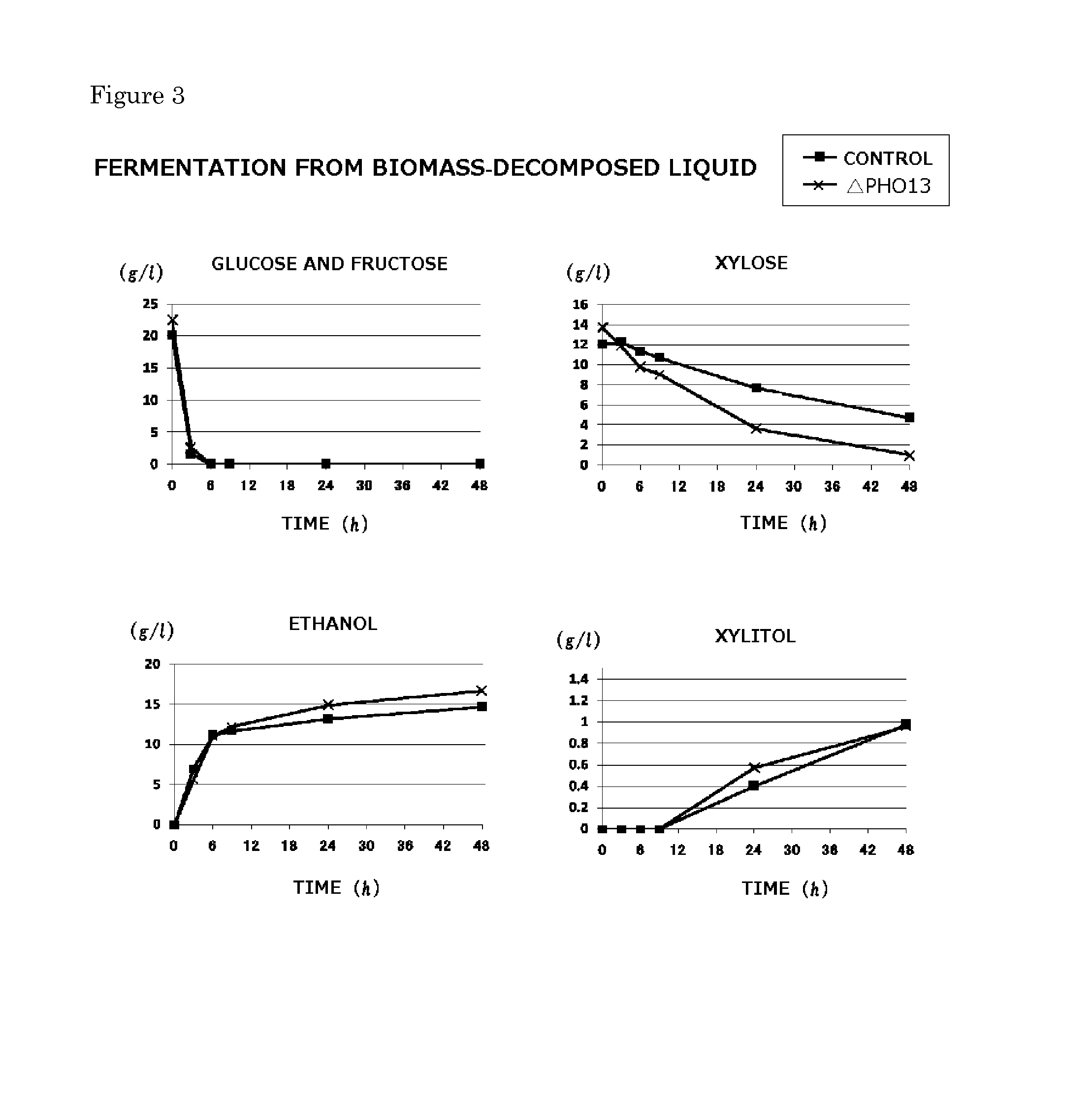Novel Method For Producing Ethanol
- Summary
- Abstract
- Description
- Claims
- Application Information
AI Technical Summary
Benefits of technology
Problems solved by technology
Method used
Image
Examples
reference example 1
Fermentation Inhibitors in Biomass-Saccharified Liquid
[0038]In this reference example, fermentation inhibitors present in a biomass-saccharified liquid using a rice straw as a raw material and subjected to a hydrothermal treatment (conditions: 130 to 300° C., 1 to 10 MPa) were confirmed. The rice straw was subjected to a hydrothermal treatment and then subjected to solid-liquid separation, followed by the recovery of a liquid fraction. After that, the pH of the liquid fraction was adjusted to 5 with NaOH and then a 1% (w / v) of a hemicellulase (G-Amano; manufactured by Amano Enzyme Inc.) was added to the liquid fraction, followed by a treatment at 37° C. for 72 hours. After that, the treated product was centrifuged at 15,000 g and 4° C. for 60 minutes, and then the supernatant was recovered. The supernatant was defined as a biomass-saccharified liquid.
[0039]The fermentation inhibitors, such as acetic acid, formic acid, furfural, 5-hydroxymethyl-2-furfural (5-HMF), vanillin, o-vanilli...
reference example 2
Consumption of Various Carbon Sources and Production of Alcohol in the Presence of Acetic Acid
[0040]In this reference example, the consumption of various carbon sources and alcohol-producing ability in a yeast (S. cerevisiae MN8140X: Non Patent Literature 3) to which a xylose-assimilating ability had been imparted were confirmed in each of the case where acetic acid was added to a solution using glucose and xylose as carbon sources, and the case where acetic acid was not added to the solution as model systems of a biomass-saccharified liquid. A medium formed of 10 g / L of a yeast extract, 20 g / L of polypeptone, 80 g / L of glucose, and 60 g / L of xylose was used as the solution using glucose and xylose as carbon sources. The cells were added to the medium so as to have an initial concentration of 50 g / L and then a fermentation treatment was performed at a fermentation temperature of 30° C.
[0041]FIG. 1 show results when the fermentation treatment was performed for 48 hours under the abov...
reference example 3
Re: Xylose-Assimilating Ability of Alkaline Phosphatase-Deleted Strain
[0042]In this reference example, an assimilating ability when xylose was used as a carbon source was confirmed for an S. cerevisiae BY4741X strain (hereinafter referred to as “BY4741X strain”), which was obtained by imparting a xylose-assimilating ability to an S. cerevisiae BY4741 strain according to the same method as the method disclosed in Non Patent Literature 3, by using a strain from which an alkaline phosphatase (PHO13) had been deleted (hereinafter sometimes referred to as “ΔPHO13 strain”). A yeast (BY4741X strain) to which a xylose-assimilating ability had been merely imparted and from which PHO13 had not been deleted was used as a control.
[0043]A solution obtained by incorporating 80 g / L of xylose into a YP medium (containing 1% of a yeast extract, 2% of peptone, and 0.5% of dipotassium disulfite) was used as a material using xylose as a carbon source. Each of the cells was added to the solution so as t...
PUM
| Property | Measurement | Unit |
|---|---|---|
| Molar density | aaaaa | aaaaa |
| Molar density | aaaaa | aaaaa |
| Molar density | aaaaa | aaaaa |
Abstract
Description
Claims
Application Information
 Login to View More
Login to View More - R&D
- Intellectual Property
- Life Sciences
- Materials
- Tech Scout
- Unparalleled Data Quality
- Higher Quality Content
- 60% Fewer Hallucinations
Browse by: Latest US Patents, China's latest patents, Technical Efficacy Thesaurus, Application Domain, Technology Topic, Popular Technical Reports.
© 2025 PatSnap. All rights reserved.Legal|Privacy policy|Modern Slavery Act Transparency Statement|Sitemap|About US| Contact US: help@patsnap.com



